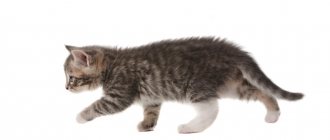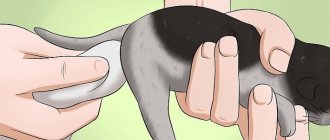Difficulty urinating is a serious problem that needs to be eliminated quickly. Without help, due to urine retention, the bladder stretches and may even burst. In the latter case, peritonitis develops, which most often leads to death. Even if the owner manages to save the animal, often due to damage to the mucous membranes of the bladder, the nerve endings die and problems with urination become permanent.
- 2 Why a cat can’t go to the toilet
2.1 Video: how to help a small kitten go to the toilet
Signs of difficulty urinating in cats
The cat's body produces 50–200 ml of urine per day. The volume depends on the individual characteristics of the animal, drinking regime, gender, age and other factors. Due to the large amount of liquid they drink and the small size of their bladder, small kittens can void up to 10 times a day. After 1 month, babies relieve themselves about 5–7 times a day. After 3 months, the number of visits to the tray is reduced to 4–6. Adult males empty their bladder up to 5 times a day, and females - up to 3. For the latter, a single visit to the litter box during the day may be an individual norm.
Changes in posture and gait, arching of the back and aggression when trying to touch the lower abdomen may indicate inflammation and pain in the bladder area
The danger is the lack of urination for 24–36 hours in adult cats and cats and for 16–24 hours in children. Acute urine retention often causes the death of pets, so you need to act quickly. Other symptoms may also indicate problems with visiting the litter box: unsuccessful attempts to relieve yourself, plaintive meowing during the process, changes in the appearance of urine, etc. The diagnosis should be entrusted to a veterinarian, but it is important to describe the pet’s condition in as much detail as possible. For example, when my cat began to have problems urinating, she began to relieve herself on the carpets and bed. At first I scolded her, but then I realized that my pet was in pain, she associated discomfort with the tray, so she tried to find a soft surface.
How to train a kitten to use the litter box
Successes may not happen on the first day. Some animals take several attempts to understand.
How to teach a kitten to go to the litter box, rules and methods:
- At first, it is common for a kitten to make mistakes when choosing a toilet. Move his affairs to the tray, take the pet there and let him sniff. Let understanding be developed by smell. And treat the place where the cat illegally peed with a repellent spray or scented product.
- If you catch a fluffy in the act of a crime, you can lightly scold him and lightly slap him on the nose with your finger. You can scold a kitten only in this way and strictly during the first seconds after it relieves itself in the wrong place. Scolding your pet near the potty is highly discouraged: he may misunderstand you and forget the way to his toilet forever.
- If the cat resists and prefers the doormat to the litter box, try spraying it with water from a spray bottle. Again: the method only works in the first few seconds. After an hour, the pet will not understand why he was punished, and a purebred cat may be offended for a long time.
- There are special sprays on sale for litter box training. You just need to sprinkle the pot with them. The smell of the product will attract the kitten.
- As soon as the fluffy one manages to determine the place for the toilet, praise him. Do not remove wet litter and “piles” immediately: let the animal get used to the fact that this is where the products of its vital activity will be located.
Advice! It is recommended to take a kitten home from the age of 3-4 months. The baby is already able to learn and obey those who are stronger.
Why can't a cat go small?
The complete absence of urination in an adult animal is due to blockage of the tubules. Theoretically, this could happen, for example, due to the formation of adhesions as a result of prolonged cystitis or acute inflammation of neighboring internal organs, but most often the problem lies in urolithiasis. In such cases, the ducts are blocked by stones, sand and blood clots formed as a result of damage to the mucous membranes. Due to irritation of the internal lining, internal edema occurs, and the tubules narrow even more. Similar symptoms in most cases are observed when stones pass through the ducts. Lack of urination with urolithiasis is more common in cats, because the urethra is wider in cats.
In cats, when passing through small stones or sand, as well as in cats, the possibility of emptying with urolithiasis remains, but the urine becomes bloody or the color of meat slop
In kittens, delayed bowel movements can also be associated with pathologies of internal organs, congenital anomalies and inflammation, but usually the symptom occurs due to a banal lack of reflex. The mother helps babies defecate when they lick their bellies. Due to stimulation by the rough tongue, the muscles relax, and the contents of the intestines and bladder freely leave the body. At first, the cat licks the feces, so the owners may think that the kitten is not relieving itself. The most characteristic sign of lack of urination is an enlarged abdomen.
If the owner is convinced that there is a problem or doubts arise, it is better to play it safe and help the baby. You need to take a coarse cloth, gauze, cotton swab or any other material with a similar texture. It is moistened in warm water (about +39°C), then the kitten’s belly is massaged first, then the groin and anus area. This will cause the muscles to relax and release urine and feces if the intestines and bladder are full.
Video: how to help a small kitten go to the toilet
Is it possible to stop an adult cat from crapping?
Training an adult cat is much more difficult than training a baby.
You will need even more patience, attentiveness to the animal and special means:
- Determine what the cat is not happy with in his litter box. Perhaps it has become too small for the pet. For this reason, it is recommended to immediately buy a large tray.
- Does the sound of the litter frighten the cat? Some animals go to trays with mesh without any filler. And vice versa, perhaps the cat does not have enough rustling backfill to properly bury his “crime”?
- Wet clay sometimes sticks to the paws, which is not something any cat would like. Try replacing the filler with wood, paper or silica gel.
- Adult cats often walk next to the litter box precisely because they are not satisfied with the litter. They have learned perfectly well where the toilet is, but they demand that adjustments be made.
- Treat the places where your pet shits most often with special sprays, for example, Antigadin. They contain disinfecting components and odorous substances.
- Replace industrial sprays with fresh lemon juice and essential oil with a pungent odor.
- As soon as the cat fidgets, move him to the tray like a baby.
- It does not harm the relationship if you slightly scare a cat that sits in the wrong place, for example, by making a loud sound. The pet will develop an association that going to the toilet in this place is dangerous.
- You discovered that the cat has already gone a little or even a lot. What to do? Try blotting up the urine with a piece of paper or using a spatula to grab a large cat's case. Move it all into the tray and don't put it away. The cat will most likely come to bury its excrement based on the smell.
- Encourage every correct action of an adult cat.
Advice! Trays with mesh are convenient for owners, but not always for pets. Some cats cling to the bars, damaging their claws.
Why does a cat walk small often, but little by little?
Frequent emptying of the bladder can be associated with 2 opposing conditions: cavity overflow or hypersensitivity. In the first case, the cause is a disruption of the central nervous system. Due to some circumstances, the nerve endings cannot transmit a reliable signal about the level of bladder filling. This causes the cat to leak urine. This condition is rare in animals and is characterized by the absence of acute symptoms. The pet does not feel any discomfort and defecates involuntarily. Problems with the central nervous system can be caused by damage to the spine, previous acute urinary retention with death of nerve cells and congenital structural abnormalities.
Problems with urination often accompany a spinal fracture; in such cases, the cat’s gait changes and he suffers from severe pain
Bladder hypersensitivity is many times more common. In this case, the animal tries to relieve itself, but this is not always successful. The pet is disturbed by false urges. The need to visit the tray appears even when a small portion of urine occurs. This may be due to a mechanical decrease in the volume of the bladder or inflammation of its walls. The first sometimes occurs as a result of an enlargement of neighboring organs (uterus, ovaries, prostate gland, etc.) in the presence of their pathologies.
Much more often the bladder itself becomes inflamed. In most cases, this occurs due to cystitis or urolithiasis. The diseases can be combined: if the urinary ducts are damaged by stones, the risk of infection increases. Bacteria can enter the kidneys and cause the development of pyelonephritis. Sometimes urethritis occurs - damage to the urinary canal.
Urine collection methods
Among the methods for collecting urine from a cat are the following:
- Cystocentesis method - urine is obtained by piercing the abdominal wall with a needle and penetrating directly into the bladder. Most often done in a clinic setting.
- Catheterization method involves inserting a catheter into the pet's bladder and obtaining urine through a special tube. The method is used in a clinical setting and is intended for animals that are unable to urinate independently.
Catheterization is dangerous due to the penetration of pathogenic bacteria through the tube into the pet’s bladder
- Collecting urine using a urine collector is carried out using a child’s urine bag or other container placed directly under the stream.
- Collecting urine from the pet's tray - before use, all foreign objects are removed from the tray, and the tray itself is disinfected.
- Collecting urine from the toilet or bathtub - if your pet is used to using the toilet, you need to cover the drain with plastic wrap and then pour the liquid into a container.
You can even collect urine from cats that prefer human toilets.
Next we will talk about each of the methods in more detail.
Cystocentesis
Cystocentesis is the most sterile method of urine collection and is more accurate than the classical use of a catheter. If it enters the genitourinary tract, microbes contained in these tracts may enter the urine, which will add a certain error to the results obtained.
The cystocentesis method helps to obtain more accurate analysis results
During the procedure, the cat is constantly conscious, since if the syringe is used correctly, the animal will not feel pain and will not twitch. When the needle is inserted, the pet can be in three positions:
- standing;
- lying down (on the side);
- lying dorsal (on the back).
It is important to fix the animal in the correct position and maintain it until the needle is removed. The cat should feel as comfortable as possible - then it will have no reason to move or resist.
Cystocentesis is performed depending on the location of the animal
The further procedure consists of the following steps:
- Try to establish contact with the cat if she is agitated. It is much more difficult to palpate the bladder in a tense body than in a relaxed one. Trusted contact is the key to quickly locating the required authority.
- You will need both hands during the procedure. With one hand, feel and fix the bladder, with the other take the syringe.
- Gently pull the organ towards you without causing pain to the animal.
- Remove the cap from the needle and begin inserting it into your pet's skin. If you perform this action gradually and smoothly, the cat will not react to what is happening.
- In order for the needle to reach its destination, it is necessary to insert the syringe all the way to the cannula in contact with the pet’s body.
- After collecting the fluid, gently relax the animal's bladder and slowly withdraw the needle.
The cystocentesis method can only be used by specialists in a clinical setting
We do not recommend this procedure be carried out by owners who do not have the appropriate skills, and we advise, if necessary, to entrust all these manipulations to a veterinarian.
It also happens that the veterinarian is unable to detect the animal’s bladder. Then the cat is prescribed an ultrasound to more accurately determine the location of the organ.
Side effects
This procedure in most cases does not have negative consequences. The exception is situations in which the animal already has pathologies that may complicate insertion of a needle into the bladder. Among the fairly harmless results of needle insertion are hematomas that go away without medical intervention. It is also possible that the vagus nerve is irritated, leading to attacks of hiccups, gagging and frequent shortness of breath.
Negative consequences of cystocentesis can occur in animals with a number of pathologies
The worst consequence is bladder rupture, which can occur if the animal already has urethral obstruction. In this regard, before collecting urine using cystocentesis, the specialist must be aware of all the diseases that have occurred in the cat’s life. Based on the anamnesis, he will prescribe the optimal method of collecting urine that does not threaten the life of the animal.
Catheterization
This method has a number of significant disadvantages, the main one of which is the likelihood of infections in the urinary system, so it should be used only when necessary. This need arises in the following cases:
- Urethral obstruction.
- Urolithiasis disease.
- Tumors of any organs of the genitourinary system that prevent the free passage of urine from the body.
Bladder catheterization process
The installation of a catheter is preceded by a special massage of the animal’s bladder, which will help move or reduce sand plugs. Sometimes the procedure is limited to the massage itself, after which the cat copes with emptying the bladder. If there is no result, the veterinarian proceeds to install a catheter.
Anesthesia
Based on the cat's health, the doctor determines whether anesthesia is necessary. The installation of a catheter cannot be called a pleasant procedure, however, even without being put into artificial sleep, the animal is able to cope with it. If the pet has crossed the ten-year mark, has heart failure or cannot tolerate the appropriate drug, a decision is made to perform the operation without anesthesia, but with general anesthesia.
The decision to administer anesthesia during catheterization is made by the owner, based on the condition of the animal.
Catheterization is accompanied by the prescription of special medications designed to dissolve the formed stones (in the case of urolithiasis) and plugs (in the case of urethral destruction). The procedure itself is done periodically until the cat is able to visit the litter box on its own.
Medication support
Upon completion of the catheter installation, the veterinarian will prescribe medications that will help the cat survive the installation of the “tube” and cope with painful symptoms:
- anti-inflammatory drugs (Cimaldzheks, Cobactan, Thiacycline);
- anesthetics (at the discretion of the veterinarian);
- antispasmodics (No-shpa, Papaverine, Platyfillin);
- antibacterial agents (Baytril 2.5%, Gentamicin, Neopen).
After catheterization, a number of medications are used to restore the pet’s health.
Manipulations with a catheter are usually carried out at home and require a veterinarian to visit the sick animal. Installing a catheter at home simplifies the pet's further recovery and does not cause additional stress for him.
Video - Installing a catheter in a cat
Collecting urine using a urine bag
Manipulations with a urine collector raise a lot of questions for many owners, meanwhile, the use of such kits greatly simplifies the extraction of urine from a cat. Since it is quite difficult to find a special cat urine collector, you can limit yourself to the children's version, sold in every pharmacy.
Baby urine bags are great for animals
The urine collector itself is a plastic container with a volume of 100 ml, the edges of which are treated with a special adhesive compound to fix this item in the area of the animal’s genitals. Many cats do not like to feel foreign objects on their body, so resistance from the pet is not excluded. If there are signs of protest, secure the urine container on top with a diaper to cover access to it. How to put a diaper on a cat is described below.
Diapers for cats: application and cost
Before collecting urine, you must thoroughly wash your pet’s perineum to avoid particles of dirt, feces, dust, etc. getting into the urine.
The next steps are:
- Remove the urine collector from the packaging after disinfecting your hands.
- Remove the adhesive tape;.
- Place the urine collector between the anus and the genitals of the animal - where the bladder is located. If necessary, use a diaper.
- Make sure that the container is full, then peel the urine collector away from your pet’s body and pour its contents into a pre-prepared container.
To successfully collect urine, naughty cats need to wear a diaper to secure the urine collection bag.
If you are performing this manipulation for the first time, it is advised to take several urine collectors at once in case your pet resists.
Collecting urine from a tray
This method is one of the easiest. In order to collect urine from the tray, you will need a syringe and a special container. Before your cat uses the litter box, you must wash it and thoroughly disinfect it. Alcohol is ideal as a disinfectant solution, as it dries instantly and does not leave an odor that would confuse your pet.
A syringe without a needle is used to collect urine from the tray and then move it into the container.
After your pet has emptied its bladder, take a syringe and withdraw the required amount of liquid, placing it in the container you need.
Urine kit
However, reality does not always coincide with the scenario described above. Some cats outright refuse to use trays that do not contain litter. For such animals, the burying ritual itself is important, and we can’t do anything about it. It is precisely for such situations that urine kits were created, designed to make life easier for the owner.
Contents of the cat urine collection kit
Urine kits are purchased in pharmacies at veterinary clinics; they are extremely rare in pet stores. The set itself consists of only two items:
- Plastic granules - their difference from other fillers is that, thanks to a special material, they do not absorb animal urine. If desired, these balls can be washed and left until next time, since they can be used multiple times;
- Pipette – it is used to collect urine.
The granules do not absorb pet urine and can be used repeatedly
In the absence of a special kit, it is allowed to use aquarium pebbles or pieces of foam. It is not a fact that the cat will like such an alternative filler, but it will also not absorb urine.
Collecting urine from the toilet or bathtub
Since some cats prefer human plumbing to cat litter boxes, there is nothing left to do but adapt to your pet’s habits. Collecting urine from a bathtub is not much different from collecting urine from a litter tray. With a toilet, the situation is somewhat more complicated, since you have to block the drain, which does not always work the first time. It will probably take several practice runs.
To collect urine from a cat using the toilet, you must first close the drain.
The ritual of preparing the bathtub and toilet for emptying the cat’s bladder is in many ways similar:
- Wash the bathtub or toilet thoroughly and disinfect the surface. Rinse with hot water to prevent soda particles from getting into your cat's urine. The use of aggressive detergents is strictly prohibited, since their composition may react with urea and significantly affect test results.
- Cover the drain with a plastic bag.
- Collect the urine with a syringe and transfer it to a container.
Do not use aggressive cleaning products to pre-clean plumbing fixtures
In both humans and animals, morning urine collection is preferred because it is more efficient. Therefore, it is advisable to track your pet’s first morning urges and monitor the first bladder emptying of the day.
Treatment
It is necessary to refrain from making an independent diagnosis and prescribing treatment. Only a veterinarian can competently assess the animal’s condition after palpation and ultrasound. Attempts to massage or palpate the bladder may rupture or dislodge stones!
Catheterization is recommended only as a last resort with confirmed urinary retention, since the procedure can increase inflammation
In case of acute urinary retention, the first step is to restore the outflow by puncturing the bladder through the abdominal wall or catheterization. After normalization of urine output, antispasmodics are prescribed to relax muscles and dilate the ducts, painkillers to alleviate the general condition and antibiotics to prevent infection. Depending on the diagnosis and the presence of complications, additional measures may be taken. For example, intravenous administration of drugs when there is a threat of developing renal failure.
Before changing your diet, it is important to consult a veterinarian, since feed formulations for different diseases of the urinary system differ greatly
During treatment, it is recommended to switch to wet food to reduce the degree of injury to irritated tissues. If necessary, the veterinarian can prescribe a therapeutic diet if the animal has kidney failure, cystitis or stones.
What to do?
If urinary dysfunction is definitely caused by stress, you should try to minimize it by giving your pet more attention and support, which is no less important for a cat than for a person.
If the cat does not like the new tray or filler, you need to return to the proven model of the tray and granules with the usual texture.
In all other cases, when the presence of a disease is evident, it is best not to try to self-medicate and contact a veterinarian as soon as possible to establish an accurate diagnosis and select the appropriate treatment.
Diagnostic methods
Without an accurate diagnosis, starting treatment is prohibited. It is important to conduct a full examination of the cat in a clinical setting before drawing up a treatment plan. Remember that even a veterinarian will not be able to reliably find out the pathology, its form and degree of development at home. Clinical examination, laboratory, ultrasound, X-ray examinations are required:
- The sound is determined by lightly tapping the abdomen (percussion) - normally it should be ringing. Palpation allows you to feel a full bladder.
- An x-ray and ultrasound reveal a dark formation of considerable size - this is a full bladder. If we are talking about anuria, then it will be empty, but greatly enlarged kidneys with signs of necrosis will be found.
- A computed tomogram is used in addition to ultrasound for a more detailed study of stones, tumors, and hyperplasia that lead to compression of the urinary tract.
- Urine examination (in case of acute retention, it is taken through catheterization) is necessary to identify infection, pus, blood impurities, as well as determine the type of stones in urolithiasis.
- A blood test is needed to assess the general condition of the cat, the presence of an inflammatory or intoxication process.
After a long (more than a day) delay in urination, it is better to leave cats for several days in the clinic’s hospital, so that if the exacerbation recurs, an emergency ultrasound can be performed, a catheter placed, or an IV with the necessary medications installed.
Should I worry?
Of course, you need to be careful about your cat’s health, but you shouldn’t panic. Before sounding the alarm, you should make changes to your cat's diet, as this is often the reason. However, if the animal does not urinate for more than a day, you should immediately contact a veterinarian. This condition can have consequences including bladder rupture and death. But before you paint such a picture, you need to do the following regarding your cat’s nutrition:
- Make sure that the animal has access to fresh water and offer it to drink.
- Eliminate milk.
- Exclude fish in any form. This is due to the high phosphorus content, which is deposited in the form of stones in the bladder.
- Do not feed your cat pork. This meat is too fatty and thickens the urine, making it difficult to drain.
- Do not give your cat raw meat.
- Eliminate salty foods.
- If possible, add special food for cats with genitourinary problems to the diet.
- Food should be rich in vitamin A, B6 and glutamic acid.
What prevents a cat from understanding where the toilet is?
Why can it be difficult to train a cat to use the litter box? Some reasons:
- The potty is unstable and the animal cannot relax.
- The tray is located for everyone to see. For secret affairs, provide your pet with a secluded place.
- When washing the tray, a scented product was used. The smell of citrus, lavender, and other strong fragrances repel the pet.
- Next to the pot there is an automatic air freshener with an unpleasant aroma for the animal.
- The tray is located next to the dining area. Cats don't shit in the places where they eat.
- Felines are real conservatives. Changing the location of the potty, a different filler, or the item itself is quite capable of discouraging the fluffy from going to the toilet where it is supposed to. It is important to first determine what kind of litter the animal likes, buy a good tray and immediately place it in a convenient place.
- The filler needs to be replaced more often. Clean cats may demonstratively go near a dirty litter box.
- Not the most popular, but possible reason is things with an ingrained smell of urine. Following its instinct, the pet goes to the sofa or carpet in the place where a small child or another pet once went. In this case, the thing or object must be thoroughly cleaned; the cat is not at all to blame.
Toilet training kittens is not a difficult task if you tackle it in a timely manner. The animal understands praise and affection, but often withdraws from scolding and even begins to crap to spite its careless owner. Teaching a cat means being patient and attentive, not swearing, not hitting your pet, and, moreover, not depriving him of food and games. In conditions of care and kind attitude, the kitten will much more quickly perceive what the owner is trying to convey to him.
How to make a cat pee
How to help a cat at home
When the cat's condition is not acute, you can try to help it yourself. For example, apply a warm heating pad to the abdomen and perineum. The pet must be petted, calmed down, and talked to. Cats feel the attitude of their owners, and the psychological state of the animal has a connection with physical health.
Many people resort to abdominal massage, but this is a common mistake. Such actions in case of problems with the urinary system will not help, but will only harm. Light massage is used for various digestive disorders.









